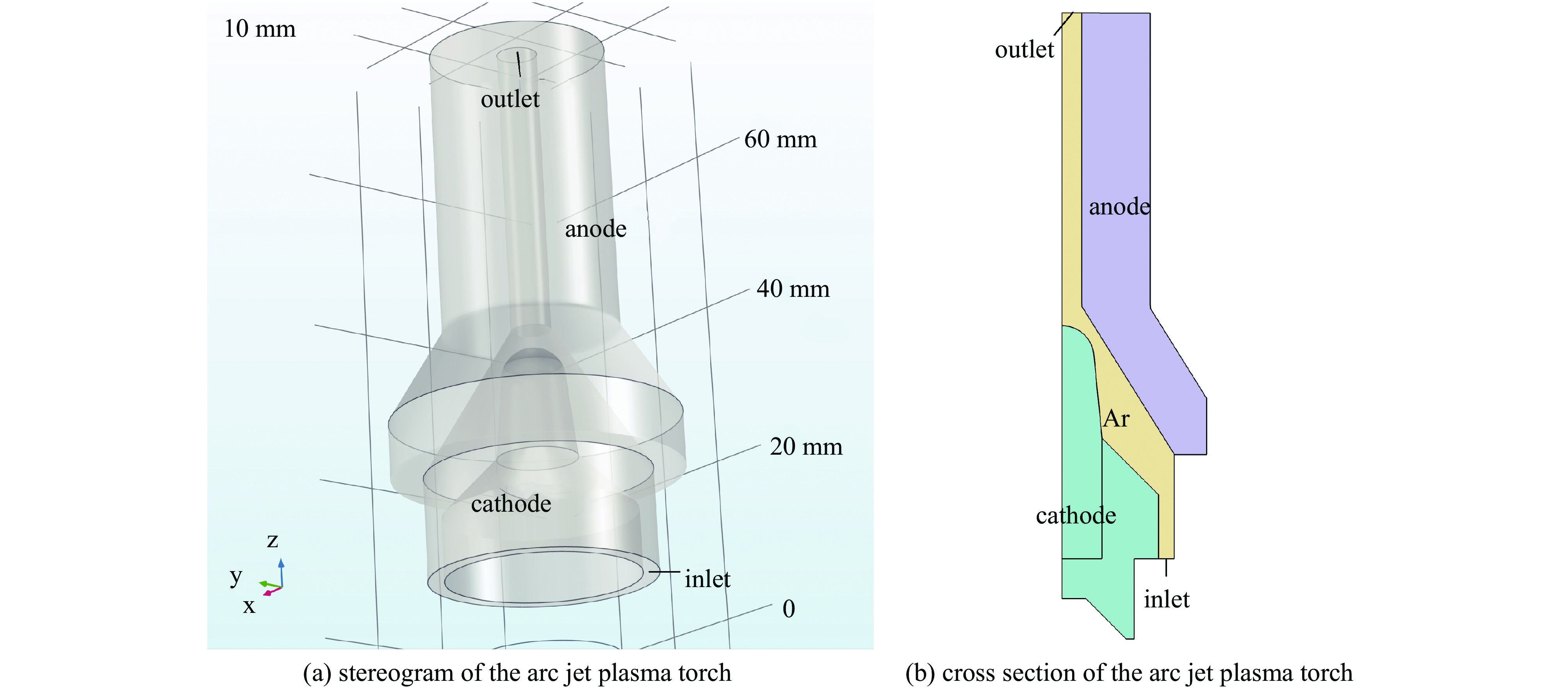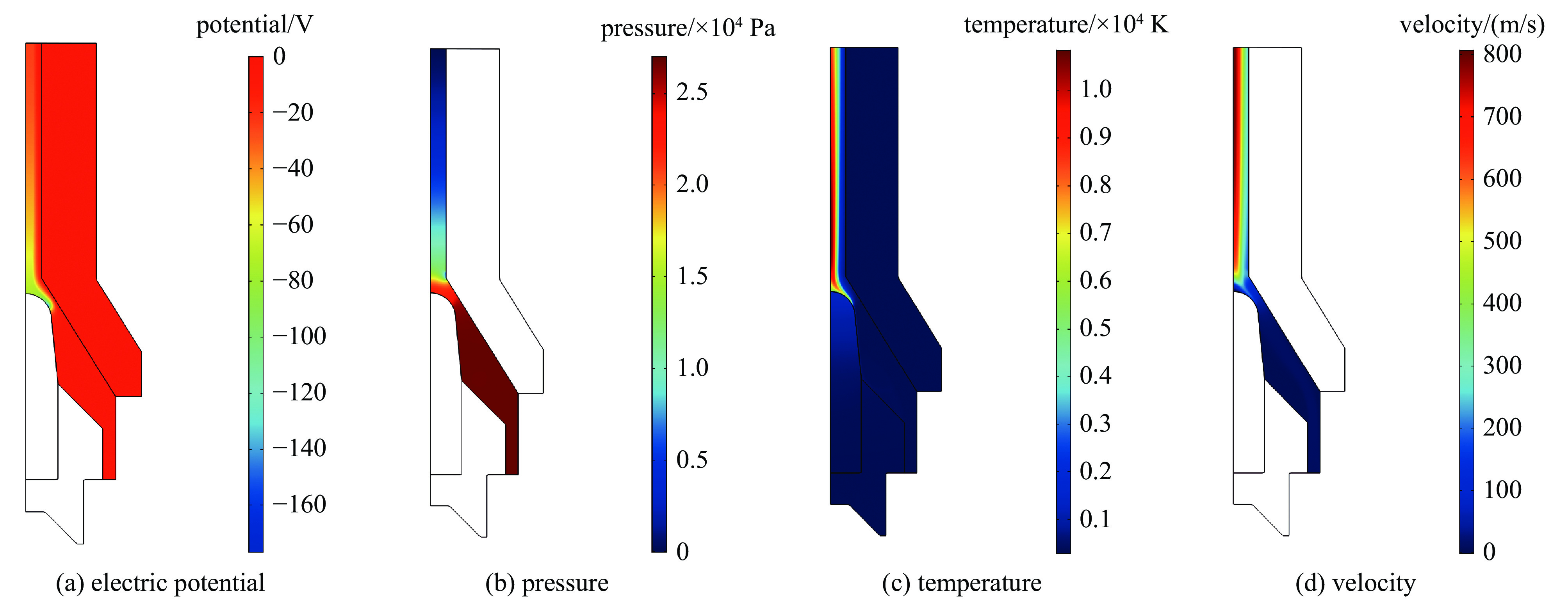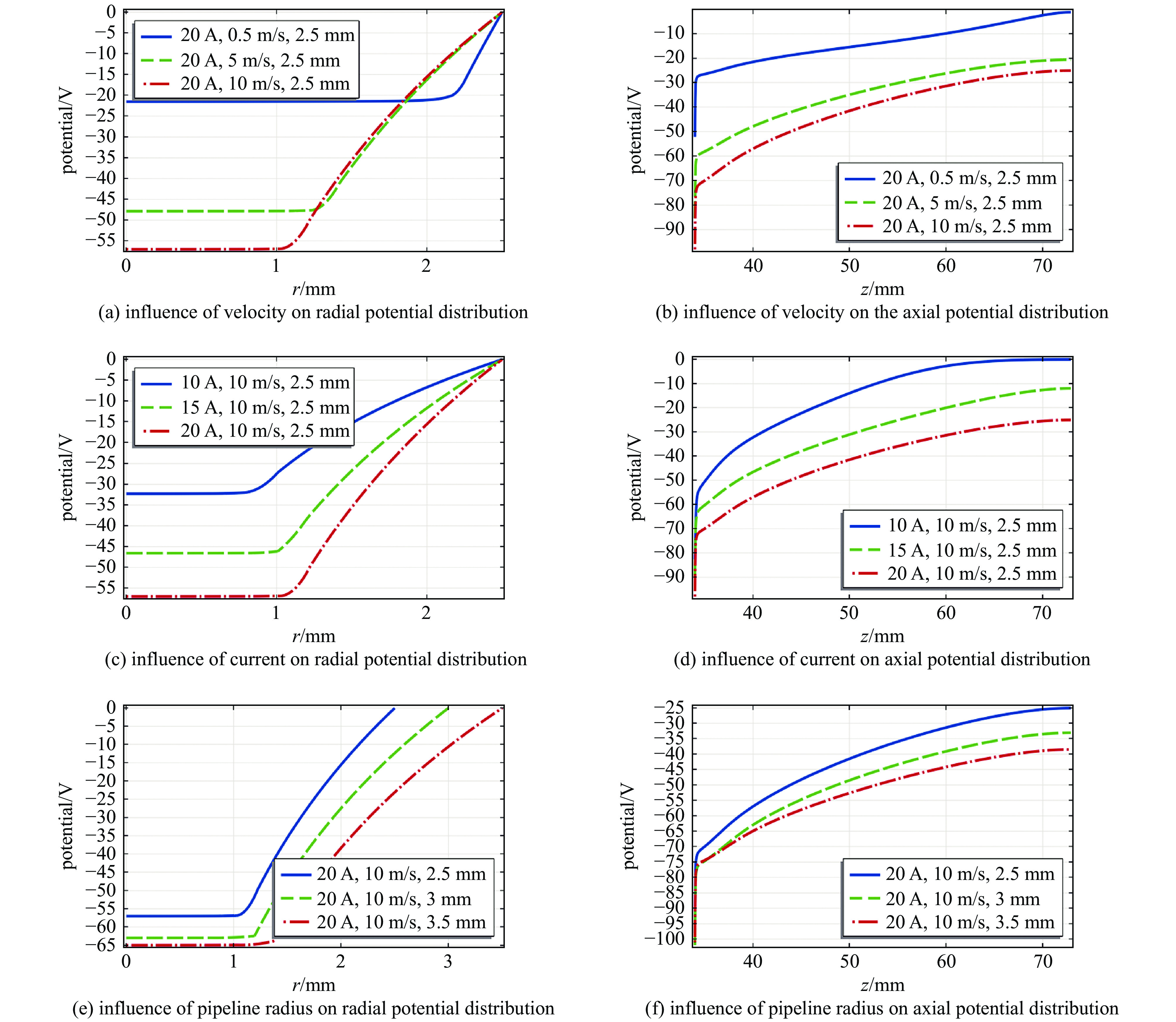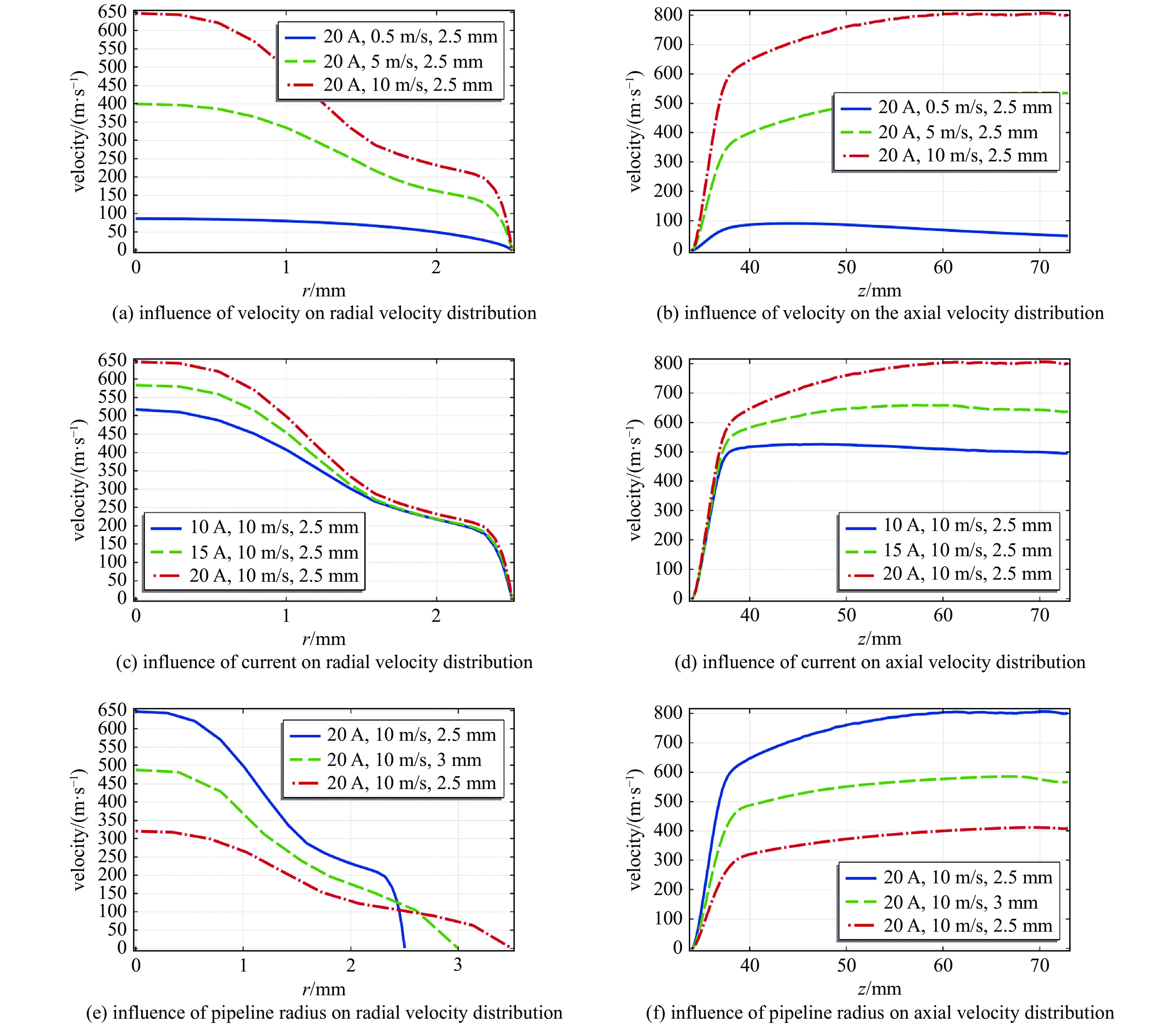Numerical study on the characteristics of an arc jet plasma actuator
-
摘要: 为了在高超声速飞行器减阻中达到更好的减阻效果,设计了一种电弧射流等离子体激励器。采用有限元法求解非线性多物理方程,对此电弧射流等离子体激励器的工作特性进行了数值模拟,得到了激励器内部的电势、压力、温度和速度分布,综合分析了进气口气体速度、放电电流、激励器管道半径对电势、压力、温度和速度分布的影响。获得了全面的影响规律,通过仿真结果还得到:电弧射流等离子体激励器可产生最高温度为8638 K、最高速度为655 m/s的等离子体射流。当电流20 A,进气速度0.5 m/s,管道半径2.5 mm时,所需功率最小;当电流20 A,入口气体流速5 m/s,管道半径2.5 mm时,出口处平均温度最高;当电流20 A,进口气体速度10 m/s,管道半径2.5 mm时,出口处平均速度最大。并对仿真得到的放电电压进行了实验验证,在等离子体参数相似的情况下,实验结果与仿真结果吻合较好。Abstract: An arc jet plasma actuator was designed for drag reduction of hypersonic vehicle to achieve better drag reduction effect. The characteristics of the arc jet plasma actuator were simulated numerically by using the finite element method to solve the nonlinear multiple physical equations, and the distributions of potential, pressure, temperature and velocity inside the actuator were obtained, and the influencing effects of velocity at the inlet, current, radius of the pipe on the distributions of potential, pressure, temperature and velocity were analyzed comprehensively. The comprehensive influence laws are obtained, and the simulation shows that the arc jet plasma actuator can produce a plasma jet with a maximum temperature of 8638 K and a maximum velocity of 655 m/s. The minimum power is required when the inlet gas velocity is the least, the maximum average temperature at the exit is obtained when the plasma current is the largest and the inlet gas velocity is medium. The maximum average speed at the exit is obtained at the largest current and the largest inlet gas velocity. Validation by experiment is also carried out. Comparison between the experimental and simulation results also show good agreement under similar plasma parameters.
-
Key words:
- drag reduction actuator /
- plasma /
- arc discharge /
- numerical simulation /
- plasma torch
-
表 1 电弧射流等离子体激励器的关键性能参数
Table 1. Key performance parameters of arc jet plasma actuator
current/
Ainlet gas
velocity/(m/s)pipe radius/
mminternal minimum
voltage/Vaverage temperature
at the exit/Kaverage speed
at exit/(m/s)20 0.5 2.5 −83.7 3035.9 26.8 20 5.0 2.5 −145.2 3994.3 308.5 20 10.0 2.5 −176.8 3185.9 424.6 10 10.0 2.5 −171.7 1963.3 275.4 15 10.0 2.5 −177.2 2565.7 340.1 20 10.0 3.0 −168.0 3035.7 281.9 20 10.0 3.5 −157.8 2982.5 199.9 表 2 实测电流电压特性表
Table 2. Measured current and voltage characteristics
inlet flow/
(L·min−1)preset current
before discharge/Astable discharge
current/Apreset voltage
before discharge/Vstable discharge
voltage/V5 7 20 493 84 7 7 21 493 130 5 8 20.2 493 86 5 8.5 21.4 493 88 5 9 21.5 493 86.7 5 9 20 494 88 5 10 21.5 494 84 5 11 22 494 80 -
[1] Dorier J L, Gindrat M, Hollenstein C, et al. Time-resolved imaging of anodic arc root behavior during fluctuations of a DC plasma spraying torch[J]. IEEE Transactions on Plasma Science, 2001, 29(3): 494-501. doi: 10.1109/27.928947 [2] Ghorui S, Sahasrabudhe S N, Murthy P S S, et al. A dc arc plasma torch as a tailored heat source for thermohydraulic simulation of proton beam–target interaction in ADSS[J]. Plasma Sources Science and Technology, 2006, 15(4): 689-694. doi: 10.1088/0963-0252/15/4/013 [3] Bhuyan P J, Goswami K S. Two-dimensional and three-dimensional simulation of DC plasma torches[J]. IEEE Transactions on Plasma Science, 2007, 35(6): 1781-1786. doi: 10.1109/TPS.2007.910214 [4] Kavka T, Matějíček J, Ctibor P, et al. Plasma spraying of copper by hybrid water-gas DC arc plasma torch[J]. Journal of Thermal Spray Technology, 2011, 20(4): 760-774. doi: 10.1007/s11666-011-9633-1 [5] Zhao Yizhe, Su Yilin, Hou Xuyan, et al. Directional sliding of water: biomimetic snake scale surfaces[J]. Opto-Electronic Advances, 2021, 4: 210008. doi: 10.29026/oea.2021.210008 [6] Bublievsky A F, Gorbunov A V, Marquesi A R, et al. Generalization of the total current–voltage characteristics for transferred arc plasma torch with steam and air plasmas based on the analytical anisotropic model[J]. IEEE Transactions on Plasma Science, 2015, 43(10): 3707-3715. doi: 10.1109/TPS.2015.2469675 [7] Mavier F, Rat V, Coudert J F. Influence of time-modulation of applied current on arc stability in DC pulsed plasma spray torch[J]. IEEE Transactions on Plasma Science, 2017, 45(4): 565-573. doi: 10.1109/TPS.2016.2631894 [8] Ondac P, Maslani A, Hrabovsky M, et al. Measurement of anode arc attachment movement in DC arc plasma torch at atmospheric pressure[J]. Plasma Chemistry and Plasma Processing, 2018, 38(3): 637-654. doi: 10.1007/s11090-018-9888-0 [9] Sun Qiang, Liu Yonghong, Han Yancong, et al. A novel experimental method of investigating anode-arc-root behaviors in a DC non-transferred arc plasma torch[J]. Plasma Sources Science and Technology, 2020, 29: 025008. doi: 10.1088/1361-6595/ab652e [10] Pan Zihan, Ye Lei, Qian Shulou, et al. Comparison of Reynolds average Navier–Stokes turbulence models in numerical simulations of the DC arc plasma torch[J]. Plasma Science and Technology, 2020, 22: 025401. doi: 10.1088/2058-6272/ab4f00 [11] Huang Heji, Pan Wenxia, Wu Chengkang. Arc root motion in an argon-hydrogen DC plasma torch[J]. IEEE Transactions on Plasma Science, 2008, 36(4): 1050-1051. [12] Lebouvier A, Delalondre C, Fresnet F, et al. Three-dimensional unsteady MHD modeling of a low-current high-voltage nontransferred DC plasma torch operating with air[J]. IEEE Transactions on Plasma Science, 2011, 39(9): 1889-1899. doi: 10.1109/TPS.2011.2160208 [13] Liang Peng, Groll R. Numerical study of plasma–electrode interaction during arc discharge in a DC plasma torch[J]. IEEE Transactions on Plasma Science, 2018, 46(2): 363-372. doi: 10.1109/TPS.2017.2786079 [14] Xu Xiaowen, Yang Shiyou, Zhou Qiang, et al. A 2-D axisymmetric magneto-hydrodynamic model of a DC arc plasma torch and its solution methodology[J]. IEEE Transactions on Magnetics, 2020, 56: 7503904. [15] Sun Jianghong, Sun Surong, Zhang Lihui, et al. Two-temperature chemical non-equilibrium modeling of argon DC arc plasma torch[J]. Plasma Chemistry and Plasma Processing, 2020, 40(6): 1383-1400. doi: 10.1007/s11090-020-10108-9 [16] Chinè B. A 2D model of a plasma torch[C]//Excerpt from the Proceedings of the 2016 COMSOL Conference in Munich. 2016. -





 下载:
下载:








